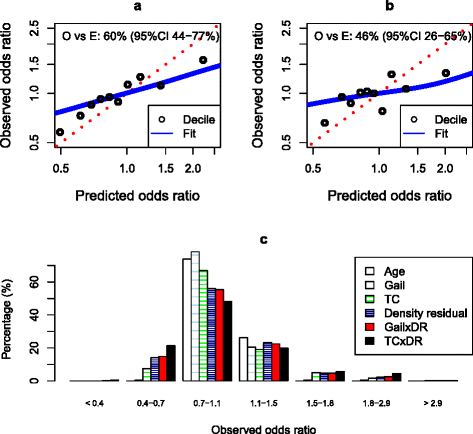Mammographic density adds accuracy to both the Tyrer-Cuzick and Gail breast cancer risk models in a prospective UK screening cohort
- PMID: 26627479
- PMCID: PMC4665886
- DOI: 10.1186/s13058-015-0653-5
Mammographic density adds accuracy to both the Tyrer-Cuzick and Gail breast cancer risk models in a prospective UK screening cohort
Abstract
Introduction: The Predicting Risk of Cancer at Screening study in Manchester, UK, is a prospective study of breast cancer risk estimation. It was designed to assess whether mammographic density may help in refinement of breast cancer risk estimation using either the Gail model (Breast Cancer Risk Assessment Tool) or the Tyrer-Cuzick model (International Breast Intervention Study model).
Methods: Mammographic density was measured at entry as a percentage visual assessment, adjusted for age and body mass index. Tyrer-Cuzick and Gail 10-year risks were based on a questionnaire completed contemporaneously. Breast cancers were identified at the entry screen or shortly thereafter. The contribution of density to risk models was assessed using odds ratios (ORs) with profile likelihood confidence intervals (CIs) and area under the receiver operating characteristic curve (AUC). The calibration of predicted ORs was estimated as a percentage [(observed vs expected (O/E)] from logistic regression.
Results: The analysis included 50,628 women aged 47-73 years who were recruited between October 2009 and September 2013. Of these, 697 had breast cancer diagnosed after enrolment. Median follow-up was 3.2 years. Breast density [interquartile range odds ratio (IQR-OR) 1.48, 95 % CI 1.34-1.63, AUC 0.59] was a slightly stronger univariate risk factor than the Tyrer-Cuzick model [IQR-OR 1.36 (95 % CI 1.25-1.48), O/E 60 % (95 % CI 44-74), AUC 0.57] or the Gail model [IQR-OR 1.22 (95 % CI 1.12-1.33), O/E 46 % (95 % CI 26-65 %), AUC 0.55]. It continued to add information after allowing for Tyrer-Cuzick [IQR-OR 1.47 (95 % CI 1.33-1.62), combined AUC 0.61] or Gail [IQR-OR 1.45 (95 % CI 1.32-1.60), combined AUC 0.59].
Conclusions: Breast density may be usefully combined with the Tyrer-Cuzick model or the Gail model.
Figures


References
-
- Evans DG, Brentnall AR, Harvie M, Dawe S, Sergeant JC, Stavrinos P, et al. Breast cancer risk in young women in the National Breast Screening Programme: implications for applying NICE guidelines for additional screening and chemoprevention. Cancer Prev Res (Phila) 2014;7:993–1001. doi: 10.1158/1940-6207.CAPR-14-0037. - DOI - PubMed
MeSH terms
Grants and funding
LinkOut - more resources
Full Text Sources
Other Literature Sources
Medical

